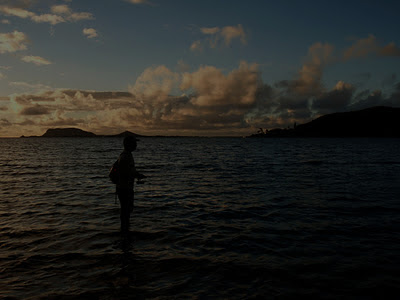There is a fellow living in Oregon who pretty much gave up steelhead and salmon to fly fish for big carp on the mighty Columbia River. His name is
John Montana. John's fishing has inspired me for years and I have long fantasized about catching one of those big Columbia River carp myself.
My chance came this past week when Tara and I, joined by my parents, spent a few days camping near Hood River. My goal was to land one carp weighing in the 'teens. Of course, I could have dreamed bigger but as a fortune cookie once said to me: sow an expectation, reap a disappointment.
My pessimism proved warranted as I learned that the water level on the Columbia, as with much of the state, was unusually high. The abnormal conditions did not bode well for me.
I spent the first afternoon with Tara, exploring the scenic banks of The Gorge, stopping here and there to look for carp. The weather was pleasant and the water was crystal clear and we found several promising spots and the few carp I spotted sunning themselves were as big as advertised. The next day the sky had gone grey and the air had turned much cooler. I tried fishing but spotting fish was nearly impossible until I was right on top of them and it was too late.
The following morning I woke up early and, leaving Tara and my parents to do some hiking, hit the water with determination - no matter how poor the conditions I would fish as hard as I could until I couldn't fish any more! I scrambled and waded, dodged poison oak and fought with blackberry brambles. Most of the fish I saw disappeared before I could make a cast, and those that didn't disappear immediately only hung around long enough to utterly reject my flies.
Sometime before lunch, tense and frustrated and wading through the muck, I had an epiphany. Actually, I slipped and fell, and then cursed as a quart of cold water made it's way down the front of my waders, and
then I had an epiphany. When I splashed down it was like a Chinese fire drill. Carp came swimming from every direction. Dozens of big fish milled about frantically, mocking my seriousness before returning to their hiding places among the weeds. I couldn't help but laugh at myself. I packed up my gear, dumped the water out of my waders and spent a lovely afternoon in Hood River with Tara and my folks.
That evening I stepped into the local fly shop. The carp had rejected all of my standard flies, and some of my non-standard ones too and so I asked myself, "what would John Montana do?" The answer was obvious. For a long time
the San Juan Worm was John Montana's go-to carp fly so I grabbed a couple, bought a new leader and headed back to camp.
The next morning I returned to the scene of my epiphany, tied on a bright red SJ Worm and waded quietly into the shallows. I soon spotted a carp cruising towards me along the edge of the reeds. It was a perfect set-up. I crouched down and made my cast. Too short! I waited until the carp was right over my fly and then made a short strip. The fish slowed down and I made another short strip. One strip too many, the carp turned and swam quickly away.
Perhaps fifty feet farther I encountered the same situation with a second fish. This time my cast was right on. The carp hurried forward and I watched it's lips flare to inhale the worm before I put tension on the line and set the hook.
The carp was determined to escape into the large weed beds near shore where my line would probably tangle and snap, but my determination to take it's photo, along with a heavy leader and a tight drag, triumphed. I soon managed to tire the fish and beach it on the muddy shore. Without a scale I couldn't be certain of it's weight but I'm very pleased with my first Columbia River Carp.



















































